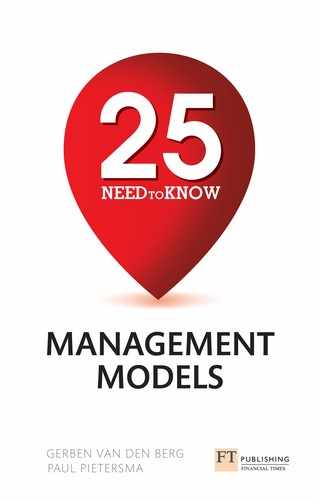Innovation circle
- Why use it? The innovation circle is a model for analysing and managing the life cycle of a new innovation.
- What does it do? Innovation processes are often complex and not easy to manage. This model identifies which phases in the life cycle of an innovation are the most important and therefore in greatest need of management focus and attention.
- When to use it? The innovation circle can be used to manage the life cycles of a variety of innovations. As the innovation process is divided into successive phases, management attention can be more easily directed to areas of need during the life cycle of the innovation.
- What question will it help you answer? How can I oversee and manage the different stages of the innovation process and focus on creating not only new products, but also products that are commercially interesting?
The big picture
The innovation circle is a model for efficiently analysing and successively managing the life cycle of a new innovation. Innovation – that is, the creation of new products, processes and services – is an essential process for creating a (long-term) competitive advantage. However, innovation processes are often complex and not easy to manage. This model identifies which phases in the life cycle of an innovation are the most important and in greatest need of management focus and attention.
The creation of new products, processes and services is a key challenge for management. The innovation circle identifies three main phases that are necessary to manage the life cycle of an innovation successfully – creation, implementation and capitalisation (Figure 17.1):

Figure 17.1 The innovation circle
Source: after Krebbekx and De Wolf (2008)
When to use it
The innovation circle can be used to manage the life cycles of a variety of innovations without overlooking relevant aspects of the innovation process. As the innovation process is divided into successive phases, management attention can be more easily directed to the correct subject during the life cycle of the innovation.
How to use it
The three phases of the innovation circle – creation, implementation and capitalisation – should be managed differently. In the creation phase, the search for new ideas is dominant. In this phase, management is directed towards managing creativity, but not in the same way as programme and project management, as search processes are not directed at a clear goal (clear goals are prerequisites in programme and project management). Rather, this phase can be managed by starting parallel research to explore different solutions. This iterative process ends when, with a degree of certainty, the most appropriate solution to the problem is found.
The implementation phase can be managed more tightly. The goal of this phase is clear from the outset and includes the different functions of the product, process and/or service. The necessary resources (mainly time and money) are therefore reasonably well known and manageable. This phase can be managed well by project management.
In the capitalisation phase, the new product, process and/or service is integrated into the ongoing operation, for which operational excellence programmes are appropriate.
The final analysis
The innovation circle is an analytical tool for managing an innovation process that provides a structure for overseeing its inherent complexity. Various analytical tools for new product management have been developed during the past few decades. The best-known tool is probably the Stage-Gate model (see Chapter 18). The Stage-Gate model and the innovation circle are comparable, in that they both provide an approach to managing the different stages of an innovation process. However, the innovation circle differs from the Stage-Gate model in two ways. First, the innovation circle directs more attention to the capitalisation phase. As such, management is not only focused on creating new products, but also on the creation of new products that are commercially interesting, and which can be integrated into the present operational infrastructure. Secondly, the innovation circle differs because of its shape. It represents a continuous process, implying that innovation should not stop at the end of a product’s life cycle. The end of a product can be a powerful incentive for new product ideas.
References
Camps, T.W., de Wolf, W. and van den Berg, G. (2011) Success!! Ten Lessons in Innovation. Utrecht: Berenschot [in Dutch: Geslaagd! 10 Lessen in Innovatie].
Krebbekx, J. and de Wolf, W. (2008) Innovation in Dutch Industry: Towards Excellence in Product Development. Utrecht: Berenschot [in Dutch: Innovatie Nederlandse Industrie].
